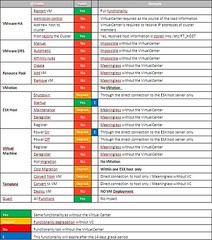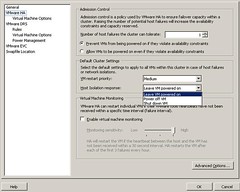Besides ESX 3.0.3 also a new VC version has been releaded! I did not notice this one yet.
Security Issues
- Updates the Apache Tomcat Server
This release of VirtualCenter Server updates the Tomcat server package from 5.5.25 to 5.5.26, to address multiple security issues that existed in the earlier releases of Tomcat server.
The Common Vulnerabilities and Exposures project (cve.mitre.org) has assigned the names CVE-2007-5333, CVE-2007-5342, CVE-2007-5461, and CVE-2007-6286 to these issues.
For more information, refer to the Apache Tomcat 5.x Vulnerabilities page.- Updates the JRE Package
This release of VirtualCenter Server updates the JRE package from 1.5.0_12 to 1.5.0_15, to address multiple security issues that existed in the earlier releases of JRE.
For more information about security issues fixed in JRE package version 1.5.0_15 and in earlier versions, refer http://java.sun.com/j2se/1.5.0/ReleaseNotes.html.
The following advisories by Secunia list the CVE identifiers related to the fixed security issues in JRE 1.5.0_13, JRE 1.5.0_14, and JRE 1.5.0_15:Note: These vulnerabilities can be exploited remotely only if the attacker has access to the service console network. Security best practices provided by VMware recommend that the service console be isolated from the virtual machine network. For more information on VMware security best practices, refer www.vmware.com/resources/techresources/726.
- VirtualCenter Server Users Without the Modify Permission Privilege Can No Longer View User Name Details of Other System Users
Starting with this VirtualCenter Server release, only users with the Modify Permission privilege can view details of other system users. When users with read-only or similar roles attempt to assign permissions to other system users, user name details of other system users are not displayed, instead, a message similar to the following appears:
Permissions to perform this operation was denied.
The Common Vulnerabilities and Exposures project (cve.mitre.org) has assigned the name CVE-2008-3514 to this issue.Virtual Machine Management Issues
- e1000 Is the Default Network Adapter Driver for Windows Vista Ultimate 32-Bit Guest Operating Systems
Starting with this release, the Windows Vista Ultimate 32-bit guest operating systems correctly detects the e1000 driver as the default network adapter driver, instead of the vlance driver.- Multiple Virtual Machines Can Be Scheduled to Power On Simultaneously
This release fixes an issue where multiple tasks that are scheduled to power on virtual machines at the same time might result in one of the following:
- The scheduled tasks might fail, with log entries similar to the following in the vpxd.log file:
[2008-02-25 03:35:04.185 'App' 6708 verbose] [VpxdMoEventManager] Event[12597]: Task <virtualmachine _name>_PowerON on <virtualmachine _name> in Data Center failed: The request refers to an unexpected or unknown type.- The VirtualCenter Server might stop responding, with log entries similar to the following in the vpxd.log file:
Exception: Not reached!
[2008-02-26 03:35:03.260 'App' 4848 error] Backtrace:
backtrace[00] eip 0x016dc006 Ordinal788
backtrace[01] eip 0x0167248a Ordinal400….- VirtualCenter Server Accepts Suffix Less Domain Entries When Updating the DNS Configuration of an ESX Server Host
This release fixes an issue where, when updating the DNS configuration of an ESX Server host, the VirtualCenter Server fails to accept valid host domain names that do not have suffixes, and displays an error message similar to the following:
The Domain name is not in the correct format- Viewing the Event Tab Page No Longer Causes the Japanese Version of VirtualCenter Server to Stop Responding
This release fixes an issue where, if an event that writes multi-byte characters to the ARG_DATA column of VPX_EVENT_ARG database table, such as accessing the console of a virtual machine, is followed by viewing the Event tab page, the Japanese version of the VirtualCenter Server might stop responding. Entries similar to the following are logged in the vpxd.log file:
[2008-03-05 17:12:18.161 'App' 5012 verbose] [VdbStatement]Executing SQL: SELECT EVENT_ID, ARG_ID, ARG_TYPE, ARG_DATA, OBJ_TYPE, OBJ_NAME, VM_ID, HOST_ID, COMPUTERESOURCE_ID, DATACENTER_ID, RESOURCEPOOL_ID, FOLDER_ID, ALARM_ID, SCHEDULEDTASK_ID FROM VPX_EVENT_ARG WHERE (EVENT_ID IN (?,?,?,?..........)
[2008-03-05 17:12:18.302 'App' 5012 error] An unrecoverable problem has occurred, stopping the VMware VirtualCenter service. Check database connectivity before restarting. Error: Error[VdbODBCError] (-1) ODBC error: () -
[2008-03-05 17:12:18.302 'App' 5012 verbose] Backtrace:Installation Issues
- VirtualCenter Server No Longer Fails to Start When Japanese Version of VirtualCenter 2.0.2 Update 2 is Upgraded
The VirtualCenter Server might fail to start when the Japanese version of VirtualCenter 2.0.2 Update 2 is upgraded to VirtualCenter 2.0.2 Update 3, or VirtualCenter 2.0.2 Update 4, with entries similar to the following in the vpxd.log log file:
[2008-05-07 15:56:59.953 'App' 5840 error] [VpxdVdb] Database version value
'VirtualCenter Database 2.0.2u1' is incompatible with this release of VirtualCenter.
[2008-05-07 15:56:59.953 'App' 5840 error] Failed to initialize VMware
VirtualCenter. Shutting down...
This release fixes the issue. The VirtualCenter Server is capable of starting, when the Japanese version of VirtualCenter 2.0.2 Update 2 is upgraded to VirtualCenter 2.0.2 Update 5.

